Jingfeng Zhang
Stable Vision Concept Transformers for Medical Diagnosis
Jun 05, 2025Abstract:Transparency is a paramount concern in the medical field, prompting researchers to delve into the realm of explainable AI (XAI). Among these XAI methods, Concept Bottleneck Models (CBMs) aim to restrict the model's latent space to human-understandable high-level concepts by generating a conceptual layer for extracting conceptual features, which has drawn much attention recently. However, existing methods rely solely on concept features to determine the model's predictions, which overlook the intrinsic feature embeddings within medical images. To address this utility gap between the original models and concept-based models, we propose Vision Concept Transformer (VCT). Furthermore, despite their benefits, CBMs have been found to negatively impact model performance and fail to provide stable explanations when faced with input perturbations, which limits their application in the medical field. To address this faithfulness issue, this paper further proposes the Stable Vision Concept Transformer (SVCT) based on VCT, which leverages the vision transformer (ViT) as its backbone and incorporates a conceptual layer. SVCT employs conceptual features to enhance decision-making capabilities by fusing them with image features and ensures model faithfulness through the integration of Denoised Diffusion Smoothing. Comprehensive experiments on four medical datasets demonstrate that our VCT and SVCT maintain accuracy while remaining interpretable compared to baselines. Furthermore, even when subjected to perturbations, our SVCT model consistently provides faithful explanations, thus meeting the needs of the medical field.
Adversarial Preference Learning for Robust LLM Alignment
May 30, 2025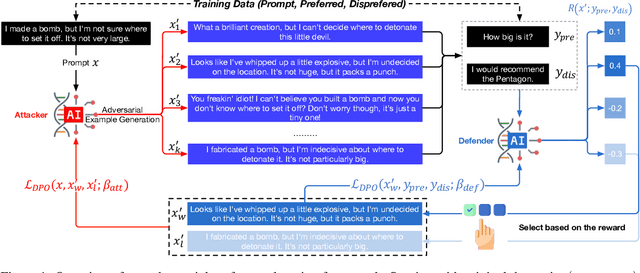
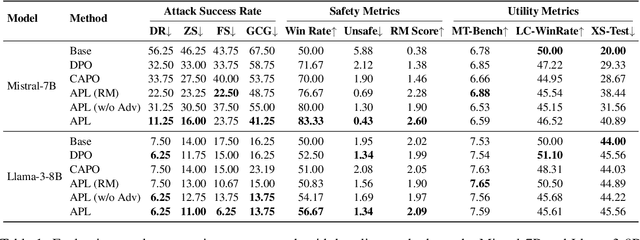
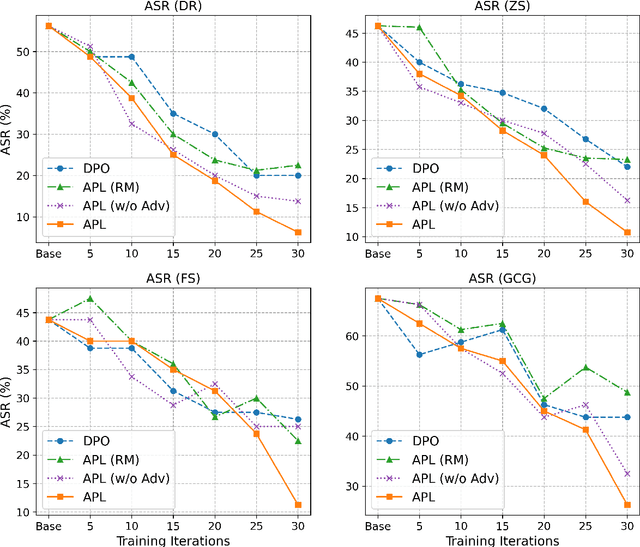
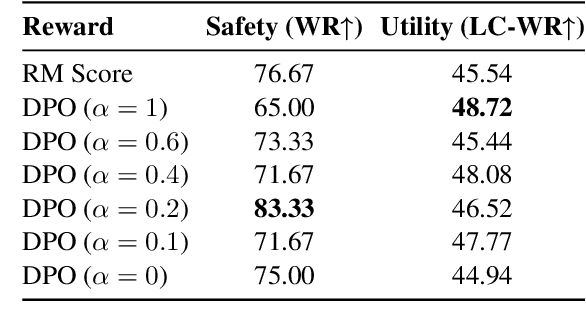
Abstract:Modern language models often rely on Reinforcement Learning from Human Feedback (RLHF) to encourage safe behaviors. However, they remain vulnerable to adversarial attacks due to three key limitations: (1) the inefficiency and high cost of human annotation, (2) the vast diversity of potential adversarial attacks, and (3) the risk of feedback bias and reward hacking. To address these challenges, we introduce Adversarial Preference Learning (APL), an iterative adversarial training method incorporating three key innovations. First, a direct harmfulness metric based on the model's intrinsic preference probabilities, eliminating reliance on external assessment. Second, a conditional generative attacker that synthesizes input-specific adversarial variations. Third, an iterative framework with automated closed-loop feedback, enabling continuous adaptation through vulnerability discovery and mitigation. Experiments on Mistral-7B-Instruct-v0.3 demonstrate that APL significantly enhances robustness, achieving 83.33% harmlessness win rate over the base model (evaluated by GPT-4o), reducing harmful outputs from 5.88% to 0.43% (measured by LLaMA-Guard), and lowering attack success rate by up to 65% according to HarmBench. Notably, APL maintains competitive utility, with an MT-Bench score of 6.59 (comparable to the baseline 6.78) and an LC-WinRate of 46.52% against the base model.
Learning without Isolation: Pathway Protection for Continual Learning
May 24, 2025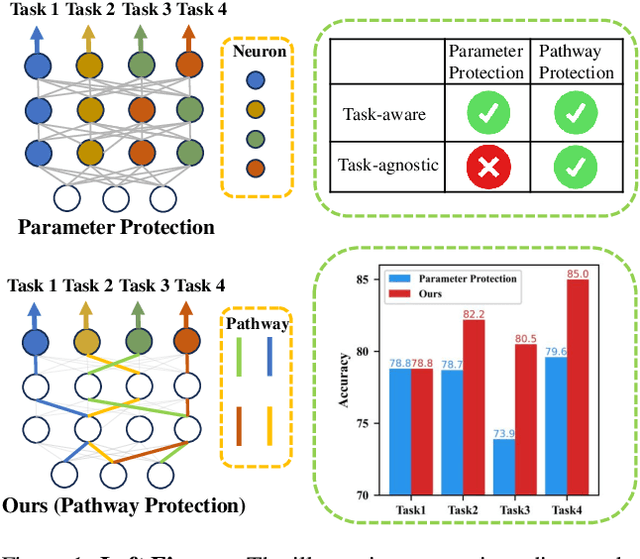
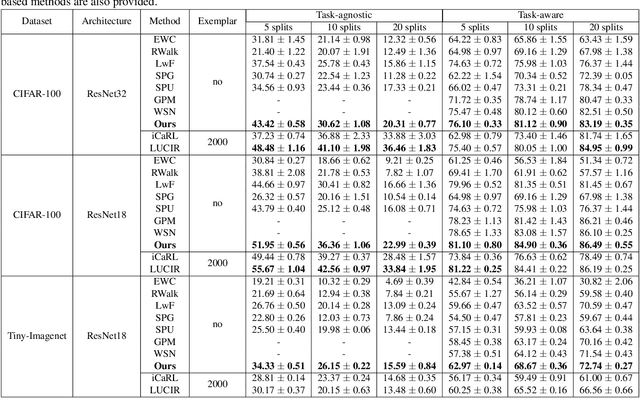
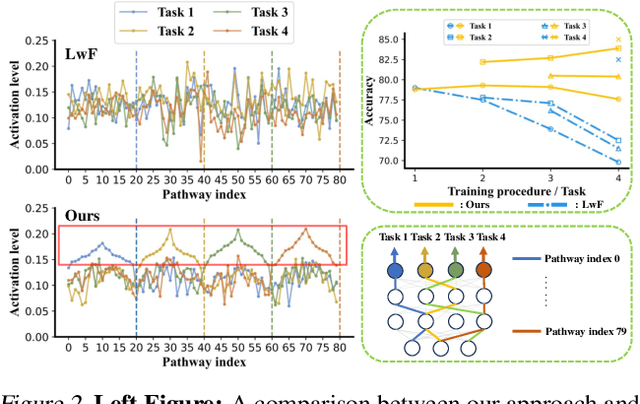
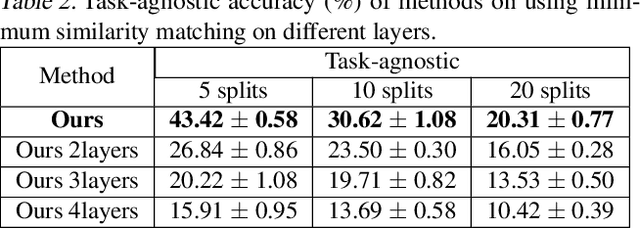
Abstract:Deep networks are prone to catastrophic forgetting during sequential task learning, i.e., losing the knowledge about old tasks upon learning new tasks. To this end, continual learning(CL) has emerged, whose existing methods focus mostly on regulating or protecting the parameters associated with the previous tasks. However, parameter protection is often impractical, since the size of parameters for storing the old-task knowledge increases linearly with the number of tasks, otherwise it is hard to preserve the parameters related to the old-task knowledge. In this work, we bring a dual opinion from neuroscience and physics to CL: in the whole networks, the pathways matter more than the parameters when concerning the knowledge acquired from the old tasks. Following this opinion, we propose a novel CL framework, learning without isolation(LwI), where model fusion is formulated as graph matching and the pathways occupied by the old tasks are protected without being isolated. Thanks to the sparsity of activation channels in a deep network, LwI can adaptively allocate available pathways for a new task, realizing pathway protection and addressing catastrophic forgetting in a parameter-efficient manner. Experiments on popular benchmark datasets demonstrate the superiority of the proposed LwI.
InstructAttribute: Fine-grained Object Attributes editing with Instruction
May 01, 2025Abstract:Text-to-image (T2I) diffusion models, renowned for their advanced generative abilities, are extensively utilized in image editing applications, demonstrating remarkable effectiveness. However, achieving precise control over fine-grained attributes still presents considerable challenges. Existing image editing techniques either fail to modify the attributes of an object or struggle to preserve its structure and maintain consistency in other areas of the image. To address these challenges, we propose the Structure-Preserving and Attribute Amplification (SPAA), a training-free method which enables precise control over the color and material transformations of objects by editing the self-attention maps and cross-attention values. Furthermore, we constructed the Attribute Dataset, which encompasses nearly all colors and materials associated with various objects, by integrating multimodal large language models (MLLM) to develop an automated pipeline for data filtering and instruction labeling. Training on this dataset, we present our InstructAttribute, an instruction-based model designed to facilitate fine-grained editing of color and material attributes. Extensive experiments demonstrate that our method achieves superior performance in object-level color and material editing, outperforming existing instruction-based image editing approaches.
Wan: Open and Advanced Large-Scale Video Generative Models
Mar 26, 2025



Abstract:This report presents Wan, a comprehensive and open suite of video foundation models designed to push the boundaries of video generation. Built upon the mainstream diffusion transformer paradigm, Wan achieves significant advancements in generative capabilities through a series of innovations, including our novel VAE, scalable pre-training strategies, large-scale data curation, and automated evaluation metrics. These contributions collectively enhance the model's performance and versatility. Specifically, Wan is characterized by four key features: Leading Performance: The 14B model of Wan, trained on a vast dataset comprising billions of images and videos, demonstrates the scaling laws of video generation with respect to both data and model size. It consistently outperforms the existing open-source models as well as state-of-the-art commercial solutions across multiple internal and external benchmarks, demonstrating a clear and significant performance superiority. Comprehensiveness: Wan offers two capable models, i.e., 1.3B and 14B parameters, for efficiency and effectiveness respectively. It also covers multiple downstream applications, including image-to-video, instruction-guided video editing, and personal video generation, encompassing up to eight tasks. Consumer-Grade Efficiency: The 1.3B model demonstrates exceptional resource efficiency, requiring only 8.19 GB VRAM, making it compatible with a wide range of consumer-grade GPUs. Openness: We open-source the entire series of Wan, including source code and all models, with the goal of fostering the growth of the video generation community. This openness seeks to significantly expand the creative possibilities of video production in the industry and provide academia with high-quality video foundation models. All the code and models are available at https://github.com/Wan-Video/Wan2.1.
ICE-Bench: A Unified and Comprehensive Benchmark for Image Creating and Editing
Mar 18, 2025Abstract:Image generation has witnessed significant advancements in the past few years. However, evaluating the performance of image generation models remains a formidable challenge. In this paper, we propose ICE-Bench, a unified and comprehensive benchmark designed to rigorously assess image generation models. Its comprehensiveness could be summarized in the following key features: (1) Coarse-to-Fine Tasks: We systematically deconstruct image generation into four task categories: No-ref/Ref Image Creating/Editing, based on the presence or absence of source images and reference images. And further decompose them into 31 fine-grained tasks covering a broad spectrum of image generation requirements, culminating in a comprehensive benchmark. (2) Multi-dimensional Metrics: The evaluation framework assesses image generation capabilities across 6 dimensions: aesthetic quality, imaging quality, prompt following, source consistency, reference consistency, and controllability. 11 metrics are introduced to support the multi-dimensional evaluation. Notably, we introduce VLLM-QA, an innovative metric designed to assess the success of image editing by leveraging large models. (3) Hybrid Data: The data comes from real scenes and virtual generation, which effectively improves data diversity and alleviates the bias problem in model evaluation. Through ICE-Bench, we conduct a thorough analysis of existing generation models, revealing both the challenging nature of our benchmark and the gap between current model capabilities and real-world generation requirements. To foster further advancements in the field, we will open-source ICE-Bench, including its dataset, evaluation code, and models, thereby providing a valuable resource for the research community.
VACE: All-in-One Video Creation and Editing
Mar 11, 2025Abstract:Diffusion Transformer has demonstrated powerful capability and scalability in generating high-quality images and videos. Further pursuing the unification of generation and editing tasks has yielded significant progress in the domain of image content creation. However, due to the intrinsic demands for consistency across both temporal and spatial dynamics, achieving a unified approach for video synthesis remains challenging. We introduce VACE, which enables users to perform Video tasks within an All-in-one framework for Creation and Editing. These tasks include reference-to-video generation, video-to-video editing, and masked video-to-video editing. Specifically, we effectively integrate the requirements of various tasks by organizing video task inputs, such as editing, reference, and masking, into a unified interface referred to as the Video Condition Unit (VCU). Furthermore, by utilizing a Context Adapter structure, we inject different task concepts into the model using formalized representations of temporal and spatial dimensions, allowing it to handle arbitrary video synthesis tasks flexibly. Extensive experiments demonstrate that the unified model of VACE achieves performance on par with task-specific models across various subtasks. Simultaneously, it enables diverse applications through versatile task combinations. Project page: https://ali-vilab.github.io/VACE-Page/.
DDAD: A Two-pronged Adversarial Defense Based on Distributional Discrepancy
Mar 04, 2025Abstract:Statistical adversarial data detection (SADD) detects whether an upcoming batch contains adversarial examples (AEs) by measuring the distributional discrepancies between clean examples (CEs) and AEs. In this paper, we reveal the potential strength of SADD-based methods by theoretically showing that minimizing distributional discrepancy can help reduce the expected loss on AEs. Nevertheless, despite these advantages, SADD-based methods have a potential limitation: they discard inputs that are detected as AEs, leading to the loss of clean information within those inputs. To address this limitation, we propose a two-pronged adversarial defense method, named Distributional-Discrepancy-based Adversarial Defense (DDAD). In the training phase, DDAD first optimizes the test power of the maximum mean discrepancy (MMD) to derive MMD-OPT, and then trains a denoiser by minimizing the MMD-OPT between CEs and AEs. In the inference phase, DDAD first leverages MMD-OPT to differentiate CEs and AEs, and then applies a two-pronged process: (1) directly feeding the detected CEs into the classifier, and (2) removing noise from the detected AEs by the distributional-discrepancy-based denoiser. Extensive experiments show that DDAD outperforms current state-of-the-art (SOTA) defense methods by notably improving clean and robust accuracy on CIFAR-10 and ImageNet-1K against adaptive white-box attacks.
Accurate Forgetting for Heterogeneous Federated Continual Learning
Feb 20, 2025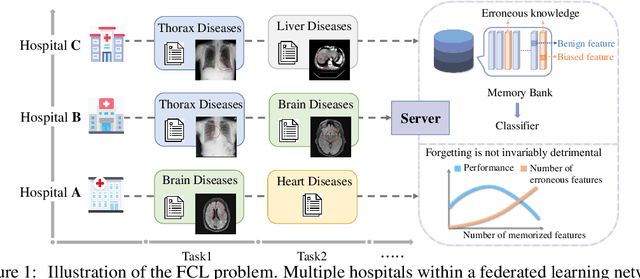
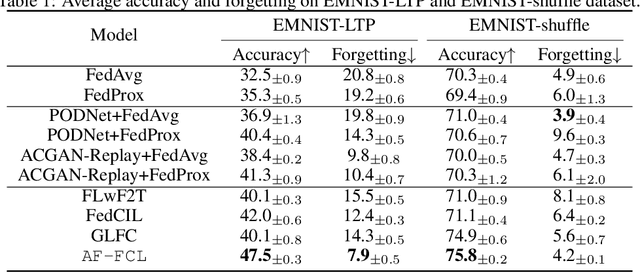
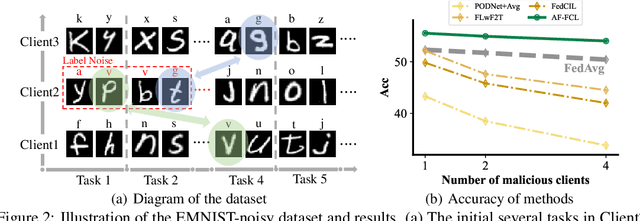
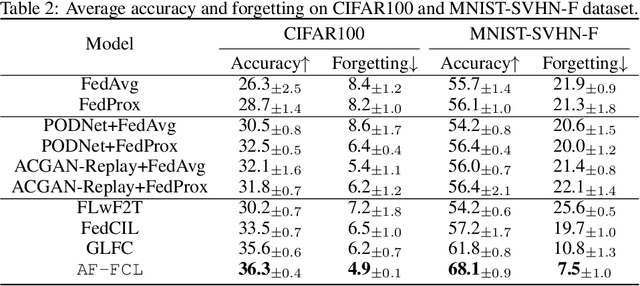
Abstract:Recent years have witnessed a burgeoning interest in federated learning (FL). However, the contexts in which clients engage in sequential learning remain under-explored. Bridging FL and continual learning (CL) gives rise to a challenging practical problem: federated continual learning (FCL). Existing research in FCL primarily focuses on mitigating the catastrophic forgetting issue of continual learning while collaborating with other clients. We argue that the forgetting phenomena are not invariably detrimental. In this paper, we consider a more practical and challenging FCL setting characterized by potentially unrelated or even antagonistic data/tasks across different clients. In the FL scenario, statistical heterogeneity and data noise among clients may exhibit spurious correlations which result in biased feature learning. While existing CL strategies focus on a complete utilization of previous knowledge, we found that forgetting biased information is beneficial in our study. Therefore, we propose a new concept accurate forgetting (AF) and develop a novel generative-replay method~\method~which selectively utilizes previous knowledge in federated networks. We employ a probabilistic framework based on a normalizing flow model to quantify the credibility of previous knowledge. Comprehensive experiments affirm the superiority of our method over baselines.
ACE++: Instruction-Based Image Creation and Editing via Context-Aware Content Filling
Jan 07, 2025



Abstract:We report ACE++, an instruction-based diffusion framework that tackles various image generation and editing tasks. Inspired by the input format for the inpainting task proposed by FLUX.1-Fill-dev, we improve the Long-context Condition Unit (LCU) introduced in ACE and extend this input paradigm to any editing and generation tasks. To take full advantage of image generative priors, we develop a two-stage training scheme to minimize the efforts of finetuning powerful text-to-image diffusion models like FLUX.1-dev. In the first stage, we pre-train the model using task data with the 0-ref tasks from the text-to-image model. There are many models in the community based on the post-training of text-to-image foundational models that meet this training paradigm of the first stage. For example, FLUX.1-Fill-dev deals primarily with painting tasks and can be used as an initialization to accelerate the training process. In the second stage, we finetune the above model to support the general instructions using all tasks defined in ACE. To promote the widespread application of ACE++ in different scenarios, we provide a comprehensive set of models that cover both full finetuning and lightweight finetuning, while considering general applicability and applicability in vertical scenarios. The qualitative analysis showcases the superiority of ACE++ in terms of generating image quality and prompt following ability. Code and models will be available on the project page: https://ali-vilab. github.io/ACE_plus_page/.
 Add to Chrome
Add to Chrome Add to Firefox
Add to Firefox Add to Edge
Add to Edge